 |
New York
Architecture Images-Upper East Side 927 Fifth Ave. |
|
architect |
Warren & Wetmore |
|
location |
927
Fifth Ave., At East 74th. |
|
date |
1917 |
|
style |
Renaissance Revival |
|
construction |
limestone-clad |
|
type |
Apartment Building |
|
|
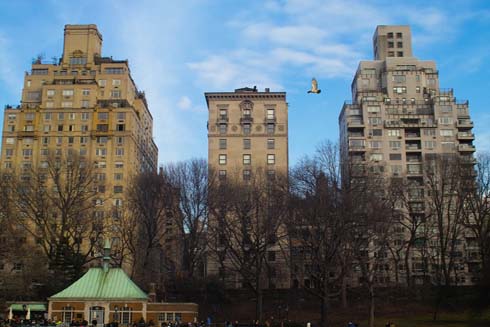 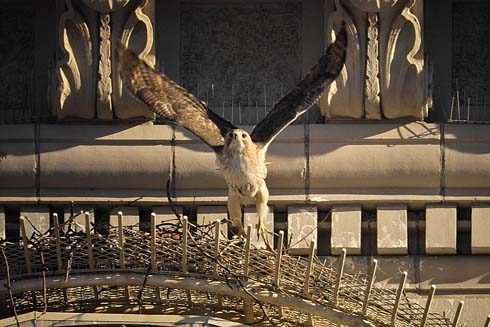 |
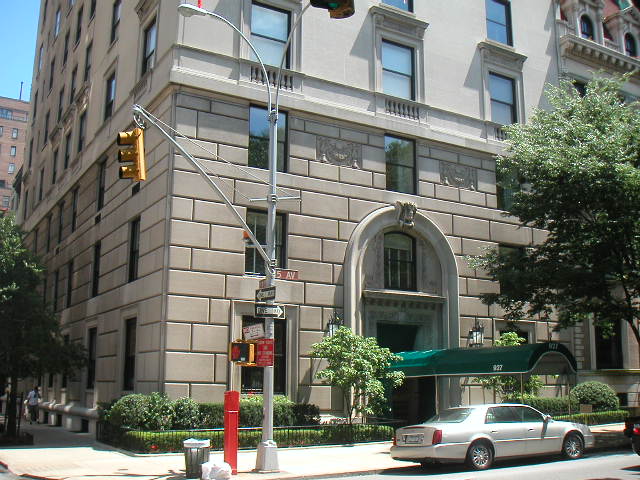 |
|
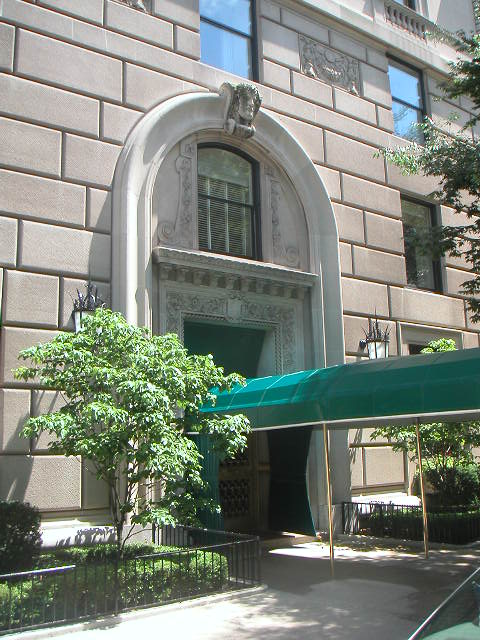 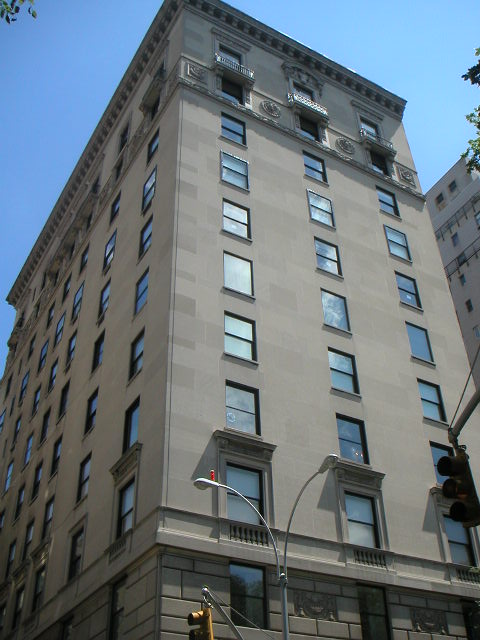 |
|
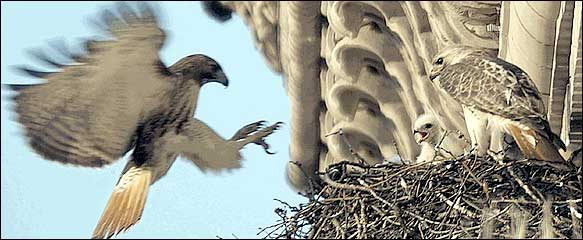 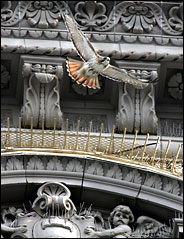 |
|
|
images |
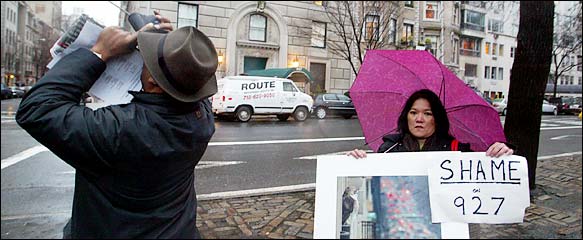 |
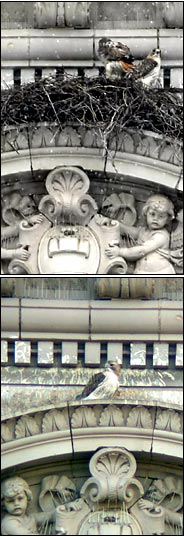 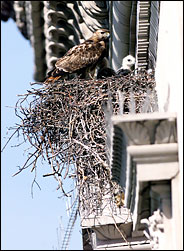 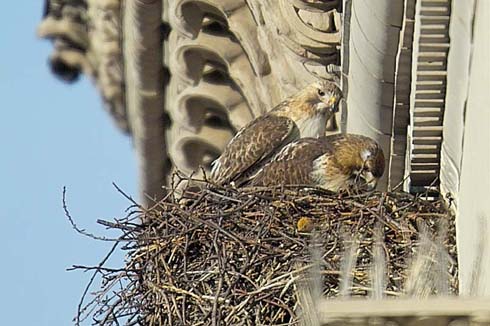 |
|
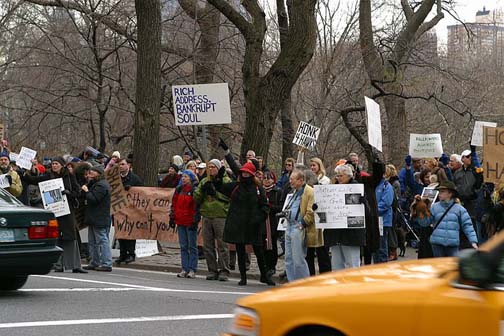 |
|
|
|
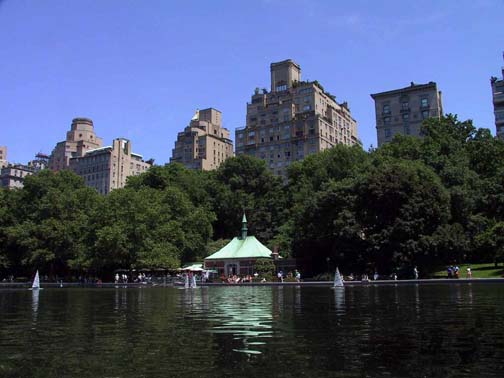 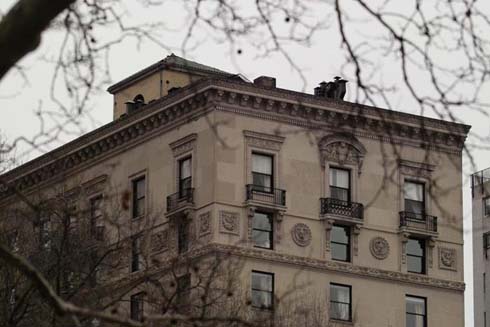 |
|
notes |
December 8,
2004 Hawks' Nest, a Fixture in New York, Is Destroyed By THOMAS J. LUECK Hawks had been living outside a building opposite Central Park. A nest constructed a decade ago by red-tailed hawks 12 stories above Central Park, creating an unlikely wildlife habitat that has delighted bird lovers from around the world, was removed yesterday, apparently by workers for its host co-op apartment building. City officials and naturalists reacted with anger, even though there appeared to be little legal recourse for the nest's destruction. Experts said that the fate of a family of uncommonly large and resilient birds, which have reproduced prolifically from the nest, had been thrown into doubt. So was that of the nest's most famous red-tailed resident, Pale Male, who arrived at the building in 1993 and, according to detailed records kept by several bird-watchers, has sired 23 youngsters. "I am so outraged that they would do this without so much as a by your leave," said Mary Tyler Moore, who has lived for 15 years in the co-op at 927 Fifth Avenue, at 74th Street, where the nest was built in 1993 above a cornice in clear view of Central Park. "These birds just kept coming back to the edge of the building, and people kept coming back to see them," said Ms. Moore, who recalled at first craning her neck outside one of her windows to look up at the bottom of the nest. In more recent years, she said, she has strolled frequently across Fifth Avenue to Central Park for a better view. "This was something we like to talk about: a kinder, gentler world, and now it's gone," Ms. Moore said last night. Exactly why the nest was destroyed was unclear. A man who answered a call to 927 Fifth Avenue's management office last night said no one was available for comment. But Ms. Moore said other residents of the building had objected to large bird droppings and, occasionally, the carcasses of pigeons - which hawks prey upon - that landed on the sidewalk in front of their lobby. She said her husband had attended a recent co-op board meeting, and had been informed of its all-but-unanimous decision to remove the nest, even though he had objected to the move. Adrian Benepe, the commissioner of the Department of Parks and Recreation, said his staff was unable yesterday to determine whether removing the nest violated any state or federal wildlife-protection laws, and would explore the matter again today. "Our domain doesn't extend to the tops of people's roofs," Mr. Benepe said. "Regardless of legality, I am concerned about whether this was ethical, or the right thing to do." The story of Pale Male and his offspring has been well documented. Marie Winn, whose 1998 book on the subject, "Red-Tails in Love," was the basis of a PBS documentary called "Pale Male," said yesterday that the nest had been removed once before, in 1993, the year it was built. She said the nest was built amid metal spikes that were placed on the 12th-floor cornice to discourage pigeons from roosting, and that the spikes had the unintended effect of providing a strong structure to brace a hawks' nest against the wind. After it was destroyed in 1993, Pale Male rebuilt, Ms. Winn said. That experience, she said, might provide evidence that Pale Male will again rebuild. But another of the bird's most ardent observers and proponents, Lincoln Karim, an engineer who has observed the nest for years with a telescope from Central Park, said he had seen workers take away the spikes yesterday. Ms. Winn said the federal Fish and Wildlife Service ruled in the 1990's that the nest was covered by a treaty adopted in 1918 to protect migratory bird habitats and could not be destroyed. But she said that more recent interpretations of the federal rules may allow people to interfere with migratory bird nests if they do so in the winter, when the nests are not used to raise offspring. Phone messages left for officials at the agency late yesterday were not answered. The nesting season for Pale Male and his current mate, Lola, does not begin until January or later, and eggs are normally laid in the nest in March, Ms. Winn said. But even now, Pale Male, Lola and other red-tailed hawks can be seen performing courtship rituals that involve flying in circles over Central Park. Whether they will attempt to rebuild the nest at 927 Fifth Avenue remains in doubt, she said, particularly because its metal supports have been removed. Even if the nest is restored, she said, the experience of 1993 does not bode well for the prospect that more offspring would be hatched next year. Ms. Winn said two years passed before Pale Male produced offspring after the last time the nest was destroyed. Colin Moynihan contributed reporting for this article. Copyright 2004 The New York Times Company www.palemale.com www.palemalethemovie.com http://www.pbs.org/wnet/nature/palemale http://www.cbsnews.com/stories/2003/07/10/sunday/main562715.shtml ----------------------------- December 9, 2004 Newly Homeless Above 5th Ave., Hawks Have Little to Build On By THOMAS J. LUECK Pale Male, a red-tailed hawk shown with his mate, Lola, top, in March, was seen Wednesday, above, at his roost, at Fifth Avenue and 74th Street, after his nest was removed on Tuesday. A day after his nest was removed from the facade of a Fifth Avenue co-op building, the intrepid red-tailed hawk known as Pale Male tried to rebuild yesterday, carrying mounds of twigs from Central Park in what experts said might be a futile attempt to reclaim his home of 11 years. "This looks like a Sisyphean task," said Adrian Benepe, the city's parks commissioner, who was one of dozens of people who stopped by the edge of the park at East 74th Street yesterday to watch Pale Male and his mate, Lola. Despite the hawks' instinctive nest building, he said, their twigs would probably blow away because a network of steel spikes that held the previous nest in place had also been removed. With the fate of the red-tailed hawks uncertain, federal officials said yesterday that the co-op at 927 Fifth Avenue, where Pale Male has occupied a 12th floor cornice since 1993, was authorized to remove the nest, despite the angry recriminations from naturalists and bird watchers. A lawyer for the co-op, Aaron Shmulewitz, said in an interview that the nest had been taken away on the advice of the building's engineer, who concluded that it violated city health and safety laws. But a spokeswoman for the Department of Buildings, Ilyse Fink, responded with skepticism. "They are trying to use city regulations as a rationale," Ms. Fink said. "If there was a valid public safety concern, we wouldn't say, 'Take the nest down.' We'd say, 'Make it safe.' " Late yesterday, about 25 people gathered across Fifth Avenue from the co-op building for a vigil called by the local chapter of the Audubon Society. They called on its residents to return the hawks' nest to its roost. "We have gotten a tremendous amount of e-mails from people who want to see the nest brought back," said E. J. McAdams, executive director of the group, New York City Audubon. "We thought this was the most expedient thing to do," he said, adding that the group had "very little success getting through" to the co-op's board or residents. "Pale Male is an ambassador of the wild in New York City," Mr. McAdams said. "We would like to see the building have a change of heart." When he arrived at the building in 1993 and built his nest, Pale Male brought an unlikely wildlife habitat that attracted bird lovers from around the world. The sight of a brightly colored hawk with wings that span more than four feet presiding over a nine-foot-wide nest in the middle of Manhattan was one hard to duplicate. And Pale Male became a celebrity. The subject of a book and public television documentary, he sired 23 youngsters from the nest that was removed on Tuesday, and became "the most famous red-tailed hawk in the world," Mr. Benepe said. But some residents of the building have long been known to consider the huge hawks, which prey on pigeons and rats, a nuisance. Mr. Shmulewitz said yesterday that the hawks had brought "torn and bleeding animal carcasses" to the building's roof and sidewalk. Until recently, the nest was protected by a federal treaty, first enacted in 1918 and administered by the Fish and Wildlife Service, which prevented the destruction of nests in migratory bird habitats. But Terri Edwards, a spokeswoman for the Fish and Wildlife Service, said yesterday that the agency had issued a clarification of the rules in 2003 that allows the destruction of migratory bird nests if it is done during a season when the nests are not being used to hatch or raise offspring. Ms. Edwards said a representative of the building had contacted her agency and obtained permission before the nest was removed on Tuesday. Pale Male's fate is a matter of intense speculation by ornithologists and bird watchers. "He will try to rebuild, but as things keep sliding off the cornice, he will be unsuccessful," said Nancy Clum, assistant curator of ornithology at the Bronx Zoo. "He may stay in the area, in a tree or on another building, or he may just pick up and leave," she said. Mr. McAdams said the chances were good that Pale Male would remain as close as possible. "Red-tailed hawks have a great fidelity to the nest," he said. "He has been very successful in that nest over the last 10 years, and he will want to stay as close as possible." Mr. Benepe said he would be happy to see Pale Male pick a tree in Central Park for his new nest, but added that the prospect was not good because red-tailed hawks prefer the stability of building facades to tree limbs, which sway in the wind. He said he would encourage building owners in Manhattan to provide platforms that might be claimed by Pale Male or other red-tailed hawks in search of a safe place. Janon Fisher contributed reporting for this article. Copyright 2004 The New York Times Company ------------------------- December 9, 2004 EDITORIAL Squatting Rights There is no historic preservation district or landmarks commission for hawks' nests. But if there were, the red-tailed hawk's nest at 927 Fifth Avenue, overlooking Central Park at 74th Street, would surely have qualified. Until Tuesday, the nest stood on a 12th-floor cornice with a sublime aerial view of the urban forest in our midst. Since 1993, 23 young hawks have been raised there, sired by a bird called Pale Male. Thousands and thousands of bird-watchers over the years have followed the lives of the hawks in that nest. But this is not an homage to bird-watching - it's an homage to birds. On Tuesday, workers took down the nest and, apparently, the metal anti-pigeon spikes that had helped hold it in place. So far, no one from 927 Fifth Avenue has spoken up to defend the co-op board's decision to remove the nest. Perhaps residents were annoyed that the hawks didn't do a better job of cleaning up after themselves by using a pooper-scooper or putting their pigeon bones in the trash, the way a human would. Perhaps they simply wearied of the stirring sight of a red-tailed hawk coming down out of the sky to settle on its nest. It's always tempting to think that a city like New York has utterly effaced the natural ground on which it was built. Most of the creatures that lived on Manhattan Island several centuries ago would stand no chance of doing so now - not in these new canyons of steel and glass. But the presence of a nesting pair of red-tailed hawks, sequestered on the edge of an apartment building, feels like a memory from a past this city has long since forgotten. The hawks have gone out of their way to learn to live with us. The least the wealthy residents of 927 Fifth Avenue could have done was learn to live with the hawks. Copyright 2004 The New York Times Company ---------------------- December 10, 2004 New York Was His Nest. And Then... (4 Letters) To the Editor: Re "Newly Homeless Above 5th Ave., Hawks Have Little to Build On" (news article, Dec. 9): Like thousands of other New Yorkers, I've often sat by the sailboat pond in Central Park, along with birders and tourists and the just plain curious - some of them with their binoculars trained on a specific ledge at the top of a certain Fifth Avenue high rise - and watched Pale Male and his mate and their young feeding and flying about, as if, as birds of prey, they owned that part of the city. And in a way they did. Not today, though. A hawk's nest is gone, and while in the grand scheme it's a small thing, it still hurts. Something inspiring, humbling and wild has been taken from the city - something that made all sorts of people happy when they learned of it and speechless when they saw it. The nest's destruction just seems such a shabby, cheap thing. Ben Cosgrove New York, Dec. 9, 2004 • To the Editor: I am like most New Yorkers. We live in cramped apartments without views. We climb endless staircases laden with groceries and laundry. We stand body to body in hot subway cars and deal with roaches as big as kiwi fruit and rats as big as dogs. So it is inconceivable to me that the residents of 927 Fifth Avenue, with their vast, luxury apartments and coveted park views, can't deal with a little waste. Last spring, I was part of a spontaneous gathering in the park that paused to watch the red-tailed hawks go to and from their nest high above 927 Fifth. Like us, they found special ways to be resilient in a city that is often inhospitable. I only hope that the hawks can continue to thrive despite those selfish residents of 927 Fifth who have sacrificed the pleasure of many for a cleaner facade. Allison Contey New York, Dec. 9, 2004 • To the Editor: I lived on the Upper East Side for two years, but moved back to my hometown, Los Angeles, this summer. Every time someone asks me what I miss most about New York, I always answer, Watching the hawks that live in that big nest on Fifth Avenue. When I found out that the co-op building had removed the nest, I started to cry. This handsome red-tailed hawk, his lovely mate and his goofy-looking fledglings brought untold hours of delight to me and to the thousands of New Yorkers and tourists who followed his saga. Many an afternoon I stopped by the telescope set up near the Central Park boat pond and watched the hawks in the nest. I wasn't alone: hundreds of people an hour would wander over. These people from around the world, speaking every language, young and old, the jaded, the curious and the just passing-by would stop and stare in complete childlike wonder at the improbable family in the nest. If the nest is not restored, New York will have lost its most charming fairy tale, real or imagined. Pale Male is the real deal. Help save the nest! Laurie Gigliotti Santa Monica, Calif., Dec. 9, 2004 • To the Editor: Amid the disasters and injustices in the world, the destruction of a hawk's nest doesn't amount to much, really, and yet how much better off we all were that the nest and those majestic raptors were above our heads. Pale Male and his consorts enriched the city with almost two dozen new red-tails over the years. Like celebrities, they were all about location, location, location: what a view they had of the park, and what a view we had of them. Like those who destroy a landmark in the middle of the night, those responsible for destroying the nest at 927 Fifth Avenue have shown their contempt for the city they call home. Matthew Wills Brooklyn, Dec. 9, 2004 Copyright 2004 The New York Times Company ------------------ December 11, 2004 No Fighting the Co-op Board, Even With Talons By THOMAS J. LUECK and JENNIFER 8. LEE One bystander trying to view a hawk Friday, as Stella Hamilton denounced the actions of the co-op. They gathered on Oct. 19 for a ritual known to thousands of New York co-op owners, the annual meeting. The board president, Richard Cohen, and his wife, the newscaster Paula Zahn, threw open their second-floor apartment overlooking Central Park for the occasion. Quickly, the discussion focused on a huge and untidy red-tailed hawk, known famously as Pale Male, which had been nesting on the building's facade for a decade. The building, 927 Fifth Avenue, is among the city's most sumptuous - apartments behind the neo-Italian renaissance facade occupy entire floors, or two, and are worth well over $10 million. The roughly 10 people at the meeting included Robert A. Belfer, the founder of Belco Oil & Gas and a former director of the Enron Corporation; Dr. Robert Schwager, a plastic surgeon with offices on the ground floor; and Dr. Robert Levine, a Manhattan cardiologist who is married to Mary Tyler Moore. Some shareholders had long complained about Pale Male and his mate, Lola, whose nest of twigs and small branches had grown to eight feet across a cornice outside the building's 12th floor. The hawks were hardly hygienic, preying on pigeons and rats, sometimes dropping bloody carcasses on the roof or sidewalk. And bird watchers were constantly looking up with their cameras and high-powered binoculars. The nest, board members said, had to go. There would be no vote among shareholders. Several people familiar with the discussions said it was Mr. Cohen who had headed the effort, even though his wife had once proclaimed her affection for the birds on television. The building's management company, Brown Harris Stevens Property Management, had warned of a public backlash. "We told Richard it would be extremely controversial," said Noreen McKenna, a Brown Harris Stevens agent who serves as secretary to the board. The story of Pale Male, how he came to live at one of Manhattan's most exclusive addresses and then was sent away, is one of wealth and fame meeting nature and instinct, of an obscure international treaty researched and clarified, and of anger among those who live in an elegant building where, Ms. Moore now says, relations have become frosty. Pale Male had adopted Central Park as his home and feeding ground, had prospered for 11 years, siring 23 hawks, and no one knows whether he will rebuild a nest and stay, or simply fly away. At the very least, his predicament serves as a reminder of an immutable force, perhaps peculiar to New York City: the power of a co-op board. At the meeting, Dr. Levine stood up to object, but not on his own behalf. "Dr. Levine was vocal," recalled Dr. Schwager, who described the Oct. 19 meeting. Neither he nor Dr. Levine is on the board. "He said, 'I can tell you categorically that Mary Tyler Moore is opposed to this.' " Dr. Schwager joined in: "I said 'This will cause a major commotion in New York if you do this.' " Both doctors were right. Since workers removed the nest on Tuesday, dangling on a window-washing platform and shoving Pale Male's carefully foraged twigs into garbage bags, the building has been the focus of searing anger from those around the city and nation who saw the hawk as an emblem of raw nature and perseverance in a densely populated urban setting. Bird lovers have camped outside, held vigils and chanted in anger, occasionally joined by Ms. Moore. Both Pale Male and Lola have been observed circling their cornice, and landing with bits of twigs and tree branches in what appeared to experts on the ground as a futile attempt to rebuild. Their nest-building may be stymied because metal spikes that held their previous nest in place have also been removed. Mr. Cohen, a real estate developer, spoke publicly about the matter for the first time yesterday and defended the co-op, on the corner of East 74th Street. "Every year this became more problematic," he said of the nest, calling the decision the result of a consensus and flatly denying he had railroaded it through. He called the eviction a "last resort" and said that board members believed the birds would thrive elsewhere, and quickly. "It takes a week to 10 days to rebuild a nest. Trees fall in nature. They lose nests. They are resilient animals." Also yesterday, Maureen Wren, a spokeswoman for the state Department of Environmental Conservation, said the agency was working with the New York City Audubon Society to protect the hawks and determining whether any state laws had been violated. The Audubon Society said that the co-op board has agreed to meet with it on Monday to discuss options. Possibilities include replacement of the spikes on the ledge or the construction of a platform elsewhere on the building's exterior. Last night, about 40 hawk supporters gathered in the rain bearing photographs of the hawks and a placard that read "Honk 4 Hawks." Ms. Moore, whose apartment is for sale for $18.5 million, was skeptical about the prospects for an amicable resolution. "These are not reversible type people," she said of her fellow apartment owners. "They just don't want the birds here." Said Dr. Schwager, "This building is unbelievably conservative and reserved. I think should we all buy lottery tickets there is a better chance we would win." The eviction of Pale Male was long in coming, and had been tried once before. The hawk's longevity in his co-op nest was due primarily due to a federal environmental treaty, signed by the United States, Canada, Russia, and other nations in 1918, that was intended to protect the habitats of several species of migratory birds, including red-tailed hawks, from poachers who sought birds for food or for their feathers. The treaty, administered by the federal Fish and Wildlife Service, were invoked in 1993 when the board of 927 Fifth Avenue removed Pale Male's nest for the first time. The removal came only months after the hawk had built the nest on his 12th-floor cornice, and his mate at the time had tried unsuccessfully to hatch eggs. Marie Winn, a bird watcher and author, whose 1998 book about Pale Male and his offspring, "Red-Tails in Love," became the basis for a public television documentary, was one of those who jumped to the hawks' defense in 1993. "They put up a scaffolding and took the nest down in a plastic bag," she said. "I got the workers to hand it over to me. I put in my bicycle basket, and took it to a secret place in the park." Then, she said, she contacted officials of the Fish and Wildlife Service, who concluded that removing the nest violated the 1918 treaty. The federal agency "put fear and trembling into their hearts" at 927 Fifth Avenue, Ms. Winn said. Board members at the co-op "promised to never remove it again, although they have always wanted to," she said. Their opportunity arrived in April 2003, when the federal agency issued what it called a "clarification" to the migratory bird treaty. Instead of a complete ban on the removal or destruction of nests, it said the nests were protected only when they were being used to hatch or raise offspring. The law "does not contain any prohibitions that applies to the destruction of a migratory bird nest alone (without birds or eggs)," said a memorandum spelling out the rule. Federal officials said this week that the clarification was intended to ensure that different species are treated uniformly, and some of the birds, like robins, simply abandon their nests after their chicks are raised. On Dec. 9, 2003, Ms. McKenna submitted an application, with photographs, to the Fish and Wildlife Service to remove Pale Male's nest. "The nest has caused deterioration of the building's canopy from bird droppings," she wrote. "In addition, the hawks bring live prey to the nest where it is killed and torn for feeding." She said the result was a danger of contamination, Lyme disease and West Nile virus. The application included a report by James E. McCosker, a building engineer who inspected the building. He described the nest as "massive," and said it posed a danger to pedestrians because it was directly above the building's entrance. "This ain't a regular nest," Mr. McCosker said in an interview. "How would you like to have a bird's nest 8 feet long and 3 feet wide overhanging the edge of the building by a foot?" On April 30, Fish and Wildlife Service officials responding in writing, saying that no permit was needed to remove the nest. "We had no knowledge that this was a famous pair of birds," said Diane Pence, the chief of the agency's division of migratory birds for the northeastern states, in an interview on Thursday. "It was just an address in New York City to us," she said, but added that the position of the agency would not have been different if the nest was in a less prominent location. Then came the October meeting, and finally, on Tuesday, workers came to take the nest down. Lincoln Karim, a 43-year-old engineer who has been among the most diligent bird watchers in tracking Pale Male and his offspring (at the Web site www.palemale.com), said he saw it happen at 2:30 p.m. After workers hung a window-washing style rigging from the roof of 927 Fifth Avenue, "I thought maybe they were checking masonry." he said. "Then I saw they were taking the nest down and putting it into garbage bags." He added, "I thought, 'I'm going to climb up ropes. I'm going to stop them.' But I looked up and saw the nest was gone. It was just gone." Other than Ms. Moore and Dr. Schwager, residents of the 11 apartments in the building have declined to be interviewed, among them Bruce Wasserstein, the Wall Street deal maker, and Ms. Zahn, who had referred to Pale Male in a 2001 segment of "The Edge with Paula Zahn," on Fox News Channel. She was interviewing two naturalists, one of whom commented on the problems associated with people feeding wild animals, and Ms. Zahn seemed eager to offer a glimpse of her personal life. "Well, guess what lives on my building, you two, a red-tailed hawk," she said. "It eats rats and pigeons on our block." "I like the hawk," she said. "I am just not going to feed it." But these days Pale Male is a sore subject among the residents of 927 Fifth Avenue. Mr. Cohen said Ms. Moore had not even mentioned the hawk when they had a friendly conversation at a recent party. She said she had been too upset to talk about it. The topic is largely off-limits when residents cross paths, she said. "We are playing the game of the elephant in the middle of the living room." Janon Fisher contributed reporting for this article. Graphic: The Legacy of Pale Male Copyright 2004 The New York Times Company --------------- December 12, 2004 As Hawks Circle, All Sides Seek Compromise By JENNIFER 8. LEE Pale Male was resting Friday in a tree in Central Park opposite his former nest on Fifth Avenue. Government officials, environmental advocates and a representative of a luxury co-op building have agreed to meet tomorrow to discuss new lodgings for Manhattan's most famous homeless couple: two red-tailed hawks, Pale Male and Lola, whose eight-foot nest was removed and destroyed on Tuesday afternoon. Daily protests in front of the building, a public outcry from across the country, and concern from some of the building's own residents prompted the chairman of the building's co-op board, Richard Cohen, on Friday to call the New York City Audubon Society, a group that has helped stoke much of the public reaction. "If there is a solution to be worked out, we would like to work it out," said Mr. Cohen, in an interview on Friday. The demonstrations continued into the weekend; yesterday, two protesters dressed up in red bird costumes. Some of the building's young inhabitants clearly sympathized with the hawks, as a handwritten sign hung on an 11th-floor window read, "Bring back the hawks." The management of the building at 927 Fifth Avenue has suggested spending as much as $100,000 to build a platform elsewhere on the building, like the roof. But environmental advocates, including officials of the Audubon Society, said such a potential solution was inadequate. They want the nest at the original location, on a 12th-floor window cornice above the building's entrance. Since Tuesday, the birds have brought twigs to the cornice in an attempt to rebuild the nest. But they have had little success because the spikes that had been placed there to ward off pigeons and had anchored the nest since 1991 were also removed by workers on Tuesday. "New York City Audubon's first goal is to have the spikes returned to the window ledge in a way that takes into account the building's health and safety concerns," said E. J. McAdams, the group's executive director. The discussions will include representatives and bird experts from Brown Harris Stevens Property Management, the building manager; the city's Department of Environmental Protection and Department of Parks and Recreation; the State Department of Environmental Conservation; and the Audubon Society. Whether a compromise can be brokered that will be amenable to the feathered couple is unclear. "It remains to be seen if what we do is enough for the hawks to return," said Adrian Benepe, the parks commissioner, whose office will represent Mayor Michael R. Bloomberg in the discussions. "If we don't and they successfully build a nest someplace else, that's O.K., too." Janon Fisher contributed reporting for this article. Copyright 2004 The New York Times Company ---------------- Hawks may return to city roost By Dan Bell STAFF WRITER December 13, 2004, 1:59 PM EST Red-tailed hawks Pale Male and Lola got the green light today to move back into their home on a Fifth Avenue building after a meeting between the co-op's management and the Audubon Society. The duo's nest and the spikes that support it were removed last Tuesday after the building's engineer said it could cause the Upper East Side structure's stone facade to crumble. "It is not a question of the structure of the building," said John Flicker, president of the National Audubon Society. "By removing the spikes they created a situation that was worse than it was before." Flicker said he expected the spikes to be returned immediately. "What we can do is make an attractive location so the birds can rebuild," he said. "They may choose not to." The nest's removal sparked several days of protests by bird-lovers and vows of support from several tenants of the tony building, including actress Mary Tyler Moore. For the past nine years, thousands of birdlovers have flocked to the building with the nest on the 12th floor ledge that has been home to Pale Male, so named for his whitish plumage. There, he fathered 25 chicks with a succession of mates -- the last three fledglings in June. The hawks also achieved a measure of world fame, through television specials and a book, "Red-Tails in Love." Audubon society experts say that while the raptors are no strangers to city life, they normally nest in trees, and there is no previous record of a pair taking up permanent residence on a high-rise building. For the past few days, Pale Male and Lola could be seen looking for their uprooted home. Lola was seen circling her former nest, carrying twigs to try to rebuild it. Later, her mate was seen perched in a tree with a pigeon he had caught. Moore said today that the building's management underestimated the birds' popularity. "I think the board of the building had no idea how far reaching the affection for these birds was," she said. "It's not only the hooks themselves, it's the camaraderie of the people who gather." The Associated Press contributed to this report. Copyright © 2004, Newsday, Inc. ------------------- December 14, 2004 Birds' Nest Will Be Saved, if Co-op Architect Says Yes By THOMAS J. LUECK A baronial Fifth Avenue co-op building at the center of an uproar over its destruction of a red-tailed hawks' nest last week agreed yesterday to try to help the hawks rebuild in the same spot overlooking Central Park - if an architect approves. "We had a very constructive meeting," said John Flicker, president of the National Audubon Society, who, along with three Audubon colleagues and city and state officials, met for 90 minutes with the president of the co-op's board, its management agent and a building engineer. "It's a much better situation today than it was yesterday," said Mary Tyler Moore, a resident of the co-op, at 927 Fifth Avenue, who has joined bird lovers and naturalists from across the nation in protesting the hawks' eviction. Still, the negotiations yesterday, part of which took place on the roof of the 74th Street co-op as the most famous of the Fifth Avenue hawks, Pale Male, circled overhead, provided only a first step toward ending a conflict that some say requires speedy resolution. "Good progress doesn't sound good enough to me," said Marie Winn, a Manhattan author whose 1998 book on Pale Male and his offspring was the basis of a public television documentary. (Channel 13 in Manhattan said yesterday that it had scheduled a rebroadcast of the film tonight at 8.) Ms. Winn was among more than 100 protesters who gathered opposite the co-op building yesterday afternoon, as they have for days - chanting, encouraging drivers to honk their horns and creating a ruckus rarely seen along one of Manhattan's most elegant residential streets. "I have suspected all along that what the co-op wants is to stall just long enough so the hawks will leave," she said. "And that could happen any day." The saga of Pale Male and his mate, Lola, who have fed happily on pigeons and rats in Central Park, reproduced prodigiously from their roost above a 12th-story cornice, and ultimately captivated the attention of much of the city, came amid unavoidable questions of what the hawks themselves will choose to do. "We haven't been able to talk to the hawks, and they may have their own plans," said Adrian Benepe, the city's commissioner of parks, who attended the meeting yesterday at 927 Fifth Avenue. Nonetheless, he said the negotiations had yielded "good progress from the point of view that the building really isn't legally obligated to do anything." Besides Ms. Moore, residents of the co-op include the newscaster Paula Zahn, whose husband, Richard Cohen, is president of the board; Bruce Wasserstein, the Wall Street dealmaker; and several other executives at the highest levels of finance. Before the hawks' nest was taken down last Tuesday, some residents had complained that the birds left the bloody carcasses of their prey on the roof and sidewalk, and their nest created a safety hazard as parts of it fell to the sidewalk, threatening pedestrians. The nest was built in 1993 by Pale Male, who foraged twigs and small branches from Central Park and assembled them on a network of metal spikes that had been placed on the 12th-floor cornice to discourage pigeons. The spikes, which were also removed last week, had the unintended effect of holding a red-tailed hawk nest measuring eight feet across in place for a decade. Mr. Flicker said a central question addressed at the meeting yesterday was whether the spikes would be restored so Pale Male and Lola could rebuild in the same place, or whether a new platform or box would be constructed and provide a sturdy base for a new nest on the co-op's roof. The Audubon Society officials insisted that the spikes be restored, and that anything else would be inadequate. Their position on the arcane question of how to provide a safe habitat for red-tailed hawks at the center of large city was buttressed by experts. The neoclassical 12th-floor cornice adopted by Pale Male, despite its ornate acanthus leaf detailing, made it "a classic red-tail cliff site," which resembled the hawks' habitat in the Western states and was far more attractive than tree limbs or a wood platform, said John A. Blakeman, an Ohio biologist who has researched the habitats of hawks and falcons. "They will absolutely reject a box," he said. According to Mr. Benepe and Mr. Flicker, Mr. Cohen seemed agreeable to returning the metal spikes to the cornice. They said participants in the meeting saw clearly that the hawks were trying to rebuild, since they had left several twigs and branches on the cornice, even though the foraged material would be blown away in a strong wind. But they said Mr. Cohen insisted on consulting the co-op's architect before making any commitment. No deadline was set, and no follow-up meeting was scheduled. "This needs to be done promptly," Mr. Flicker said. "The longer you wait, the longer the risk to the birds." "We wanted them to say the spikes will go up," Mr. Flicker said, adding that he hoped hear the co-op's decision in the matter today. Yesterday, Pale Male and Lola were a clear presence over the east side of Central Park, circling above the co-op and the park's picturesque model-boat pond and, in Lola's case, casually devouring a pigeon on a tree limb as dozens of bird enthusiasts looked on. Ms. Moore, who has shed the retinue of agents, public relations specialists and others who normally surround celebrities in proclaiming her support for the hawks, emerged from 927 Fifth Avenue to answer questions from reporters. "I just want to make sure that they take into consideration what the birds' instincts are going to be," she said. "I don't object to anything," Ms. Moore added. "I don't care if they hang a nest from my living room window, that's fine." "I just want those hawks to be back in their natural habitat and be peaceful." Janon Fisher contributed reporting for this article. Copyright 2004 The New York Times Company ---------------- December 15, 2004 Co-op to Help Hawks Rebuild, but the Street Is Still Restless By THOMAS J. LUECK A week after it removed a red-tailed hawk's nest from its facade and was met by a storm of protest, a Fifth Avenue co-op building agreed yesterday to requests by the Audubon Society to help the hawks rebuild. But the agreement came on a day of heightened tension outside 927 Fifth Avenue, the sumptuous co-op where the hawks have roosted on a perch overlooking Central Park for 11 years. The co-op is also home to some of the biggest names in New York society. With negotiations taking place inside, those protesting the removal of the nest continued their vigil across Fifth Avenue in Central Park. One of them, Lincoln Karim, an engineer, was arrested on charges of aggravated harassment, stalking and endangering the welfare of a child. Mr. Karim, who was being held last night at the 19th Precinct station house, was accused of approaching the television newscaster Paula Zahn and her family, who live in the building, on several occasions, the police said. At one point he told Ms. Zahn's 7-year-old son, "Your parents are going to pay for this," according to law enforcement officials with knowledge of the case. Officials said that encounter occurred on Monday outside the building as the boy and his nanny were walking his dog. The arrest of Mr. Karim prompted a swift response by another of the co-op's many celebrity residents, Mary Tyler Moore, who has publicly allied herself with the protesters. Soon after Mr. Karim was approached by four detectives and driven away, Ms. Moore and her husband, the Manhattan cardiologist Robert Levine, hailed a cab and drove to the 19th Precinct station house to assist Mr. Karim, although they were not aware of the charges against him, according to Marie Winn, a Manhattan writer, bird watcher and friend of Ms. Moore's who joined in the cab ride. Mr. Karim runs a Web site for bird lovers, www.palemale.com , named for the male hawk. "Mary Tyler Moore was magnificent," Ms. Winn said. When she was unable to speak with Mr. Karim and determine the charges against him, Ms. Moore returned to speak to a group of about 40 protesters who remained opposite 927 Fifth Avenue. She was greeted by loud applause, and thanked her fellow demonstrators. "That applause is the best applause I have received in my life," Ms. Moore said, according to two people who were present. The agreement forged by Audubon Society and co-op officials centered on a strategy to allow the hawks, Pale Male and Lola, to rebuild their nest in the same spot on a 12th-floor cornice. The co-op, led by Richard Cohen, its board president and Ms. Zahn's husband, had sought to steer the hawks to another location on the building by providing a platform or box, but agreed yesterday that "the hawks will return to the same spot," Mr. Cohen said in an interview. The co-op was clearly under pressure to compromise. Another of its well-known shareholders, Bruce Wasserstein, the Wall Street deal maker, tried in recent days to persuade Mr. Cohen to settle, according to someone close to the family who spoke on the condition of anonymity. Within days, said Mr. Cohen and John Flicker, president of the National Audubon Society, a network of steel spikes are to be erected on top of the hawks' 12th-floor cornice. The spikes are meant to duplicate others that were installed to discourage pigeons but served as an anchor for the nest until they were removed. Audubon officials agreed to a plan by the co-op's architect to surround the spikes with some form of protective rail that would prevent the sticks and small branches used for nest building from falling to the sidewalk. Co-op officials said they had removed the nest after some residents complained about the carcasses of pigeons that the hawks dropped onto the sidewalk after devouring. Mr. Cohen said the design of the rail must be approved by the city's Landmarks Preservation Commission, since the co-op is in a landmark district. But he said he expected landmarks approval to come quickly, and Robert B. Tierney, the commission's chairman, said Monday that the approval could come within hours after an application was filed. By engaging an architect, the co-op can "create a secure and stable environment that should enable the birds to return to their home of more than a decade," Mr. Flicker said in a statement. "I think we have a great deal," said E. J. McAdams, executive director of New York City Audubon, the local chapter of the Audubon Society. Mr. Cohen said the plan was meant to carry the hawks through their mating season, which begins in January and, if successful, will culminate when Lola lays eggs in March. After that, he said, other measures may be considered to make the nest less of a nuisance, but without removing it or moving it elsewhere. Howard O. Stier, Michael Wilson and Jennifer 8. Lee contributed reporting for this article. Copyright 2004 The New York Times Company |
Category: Culture: Real EstatePale Male Update: The Hawks Shall Come HomeAs of yesterday, the National Audubon
Society had struck a deal with CNN anchor Paula Zahn and her gang of
evil co-opsters at 927 Fifth Avenue to ensure that recently-evicted hawk
Pale Male (and his lady friend, Lola) would be able to rebuild their
nest atop the building's overhang. The weekend's protests, however,
resulted in the arrest of Lincoln Karim, the super bird The Suffering Social Scene At 927 Fifth AvenueMore on the homeless hawk crisis on the Upper East Side; the removal of a famous hawks' nest has created a chilly holiday spirit: But these days [resident hawk] Pale Male is a sore subject among the residents of 927 Fifth Avenue. Mr. Cohen said Ms. [Mary Tyler] Moore had not even mentioned the hawk when they had a friendly conversation at a recent party. She said she had been too upset to talk about it. The topic is largely off-limits when residents cross paths, she said. "We are playing the game of the elephant in the middle of the living room." The real victims here are clearly the
residents. Who'll host Bunko night now? This Was The Year That The Birdies Died
At the time of publication, Smooth Touch wasn't answering their smooth phones, so we're extra curious to find out what the hell that place is. Earlier:
UES Building Likes Their Hawks Homeless 927 Fifth Avenue: Hawk Haters RevealedWhen a hawks' nest was abruptly removed from its co-opted perch at 527 Fifth Avenue, animal lovers and city officials raised ethical questions and Mary Tyler Moore threw a hissy fit. In case you were wondering what sort of evil people would force hawk homelessness, it's none other than Paula Zahn and friends! Building residents include:
Who's Who At 927 Fifth Avenue [Curbed] UES Building Likes Their Hawks Homeless
"I am so outraged that they would do this without so much as a by your leave," said Mary Tyler Moore [...] "This was something we like to talk about: a kinder, gentler world, and now it's gone," Ms. Moore said last night. As anyone who's seen Mary Tyler Moore
lately would attest, someone who feasts on the flesh of the living
during hours of darkness is naturally going to have a little sympathy
for fellow creatures of prey. thanks to http://www.gawker.com/ |
|
|
December 19, 2004 WORD FOR WORD | 'BIG BIRD' A New Pecking Order on Fifth Avenue By PETER EDIDIN In happier days, Lola returns to the nest, and to a hungry gosling, under the watchful eye of Pale Male, right. NEW York has its first celebrity bird. Not a mere curiosity, like the dancing chicken in Chinatown, but a player. Pale Male, the red-tailed hawk resident since 1993 on a 12th-floor perch at 927 Fifth Avenue, overlooking Central Park, clearly meets the criteria. Not only have he, his mate, Lola, and their offspring (23 and counting) been the subjects of books, documentaries and pilgrimages by thousands of rapturous fans, but he has the political clout to face down some of the city's best-connected inhabitants. On Dec. 7, the co-op board of Pale Male's building had his nest removed, provoking instant outrage from individuals and groups around the city, country and even internationally. Soon, sign-waving demonstrators were camped out in front of the elegant building, and while Pale Male soared serenely above the fray, the co-op board sued for peace. Last week, it agreed to let the bird rebuild his nest. New York Civic, a public interest group founded by Henry Stern, a former New York City Parks Commissioner, collected the e-mails it received on the controversy on its Web site ( www.nycivic.org ). They show passion, wit, some nuttiness and even a willingness to examine both sides of the question. Excerpts follow. • If Fifth Avenue doesn't want them, we would love to have them on S.I. [Staten Island]. Our pigeons are just as tasty and not as pricey. We might have more dirt underneath our fingernails, but our noses aren't pointed skyward. We tend to speak quickly and lose our "R's" in the process, but we talk forthrightly and never refer to each other as "lovey" or "darling." Anonymous No one mentions the homeless homo sapiens here very much anymore. L.D. The board and residents of 927 Fifth Avenue, M.T.M. excepted [Mary Tyler Moore, who lives in the building], have shown the world what pathetic specimens of the human race they are, and have demonstrated once again the continuing decline of Western civilization in all their wanton disregard for nature and the wonderful planet that has made their small lives possible. C.R. Thank you for supporting the hawks! Ms. Winters, the owner of the apartment where the birds nest, should be evicted from NYC. How dark is her heart? Goes to show, money can buy you everything, but not class! And Paula Zahn [who lives in the building], I will never watch her ever again! May she move to North Dakota and stay there!!! F.W. Disgusting, outrageous, and infuriating. I'm almost at a loss for words. R.B. Let's imagine that Mrs. Gotrocks on the 12th floor of that building spills some oil while preparing her dinner (O.K., she's rich, so her cook/maid/whatever does it), and it catches fire. The Fire Department responds, and while the brave firefighter ascends the ladder to rescue Mrs. Gotrocks (or the cook/maid/whatever), he/she is attacked by a hawk, falls from the ladder and dies. Can your imagination foresee the negligence claims against the co-op? They harbored wild animals!! Dangerous wild animals!! They allowed the dangerous situation to exist for 11 years!! You can even remove some of the sensationalism by substituting a lowly window washer for the brave firefighter (or add to it by making it a child leaning out the window to look at the hawks, or increase it further by making it the child of the cook/maid/whatever), but the lawyer's claims probably wouldn't change. And this is NOT an unlikely scenario! Anonymous So the residents of Fifth Avenue find their eating habits offensive? Just because your meat comes in a boneless filet doesn't mean there is no carcass. Letting some minimum-wage worker do your dirty work does not separate you from the rest of the carnivores. Anonymous Let's make this a cause, and DRIVE THEM NUTS. V.J. By the way, the best news - pigeon problems for the rich at 927 will increase because they removed the spikes and the natural controls. Ha! B.F. The answer is simple. Like all true pioneers, it's time for these hawks to go west. Over here on West 71st Street, we would welcome them to the neighborhood. Nobody more famous than they lives in our humble building, and we would be honored to work out a suitable roofline penthouse. T.C. This public keening over two birds is ludicrously disproportionate to any reasonable aesthetic or moral valuation - and property rights are moral, too. Worry about Islamic terror, Social Security solvency, U.N. corruption, the appalling state of our schools, wasting a billion dollars on an in-town stadium and the insufferable arrogance in Albany (compared to which NYC co-op boards are models of modesty). Fear not: Sooner or later some co-op board will do something really awful, but not this time. J.C.W. As neighbors, living half a block away from the nest of Pale Male and Lola, we have been out picketing on the street every day and have sent letters to each resident of the building. The arrogance and total lack of concern of these extraordinarily privileged people is symptomatic of the way many liberals ... only care for what is not in their backyard. If an environmental situation develops some place else, they are the first to show concern for an endangered tree toad in Arizona. They think nothing of blocking a dam or highway project, but let a pair of hawks nest in their building that give the citizens of New York genuine pleasure, they turn deaf ears to what has become a national outcry. B.G. The Pale Male episode just proves the truth of the old adage: Money can't buy class. A.D.F. Any New Yorker who helps reduced the pigeon population, free of charge, and in an environmentally responsible way, deserves to build a home on Fifth Avenue. D.M. My T.R.-style tree-hugging credentials earn me the regular spite of my more conservative fellow Republicans. But in this case, Mr. and Mrs. Male have a tremendous monument to nature (and to man's reverence for it) available to them in Central Park. Can't they simply move across the street? I don't doubt that some of the human residents of 927 are vile, wealthy cretins, but I don't particularly begrudge them for asking Mr. and Mrs. Male to cross the avenue. J.F. Like all issues - I understand there are two points of view - an EIGHT-FOOT NEST! That's bigger than some studio apartments - perhaps the hawk should have been charged maintenance by the co-op - he could earn it from the film rights, etc. J.D. Copyright 2004 The New York Times Company -------------------- December 22, 2004 New Aerie Is Readied for Fifth Avenue Hawks By THOMAS J. LUECK A stainless steel cradle designed to support a new nest for Pale Male and Lola, the red-tailed hawks of Fifth Avenue, is to be installed tomorrow on the co-op building where the hawks' former nest was removed on Dec. 7, according to the co-op's board and architect. Naturalists and city officials yesterday praised the architect's design, and the co-op's timing, saying the cradle could resolve a dispute that has captivated bird lovers across the nation, while providing Pale Male and Lola with a safe roost from which to hatch fledglings next year. "It perfectly melds our concerns for Pale Male with the concerns of the building," said E. J. McAdams, the executive director of New York City Audubon, who joined the architect, Dan Ionescu, on a visit to a Long Island machine shop where the framework was nearing completion late yesterday. "We are all looking for Pale Male to come home for the holidays," Mr. McAdams said. The new structure will incorporate steel pigeon spikes that were removed with the old nest when it was hauled down from a 12th floor cornice of the building, which is at 927 Fifth Avenue and overlooks Central Park at 74th Street. The spikes had prevented the hawks' nest, which grew over a decade to a width of eight feet across and to 400 pounds, from blowing away. But the cradle also includes a guard rail and platform to prevent sticks and branches from falling to the sidewalk, a hazard posed by the old nest, according to some residents. Mr. Ionescu, whose Manhattan firm was assisted by Beyer Blinder Belle, the architectural firm responsible for restoration projects at Ellis Island and Grand Central Terminal, said he and his staff had been working almost without interruption since last Friday. "We had to make sure the end result would be a cradle where Pale Male would rebuild a nest, and that would assure the integrity of a landmark," he said. The city's Landmarks Preservation Commission has already approved the design. Mr. Ionescu said Audubon officials and naturalists had insisted that the protective guard rails not prevent Pale Male and Lola from fully extending their wings, which in Pale Male's case are more than four feet from tip to tip. That is why the rails will be contoured along the arch of the 12th-floor cornice. Adrian Benepe, the city's parks commissioner, also remarked on the timing of the installation. "I've been referring to it as a crèche," Mr. Benepe said. But there is no assurance that Pale and Lola will immediately adopt the cradle as a new home, Mr. McAdams said. Nonetheless, both hawks have been sighted flying over Central Park, and they show no inclination to go away. Mr. McAdams said they would have plenty of time to rebuild before their annual courtship rituals, usually in February. Lola typically lays her eggs in early March. "We think the timing is perfect," Mr. McAdams said. Copyright 2004 The New York Times Company ----------------------- December 22, 2004 A Happy Tale for the Birds: Wings Wide, Pierre Is Free By COREY KILGANNON Christopher A. Nadareski released a red-tailed hawk, named Pierre by his rescuers, Tuesday. Not every red-tailed hawk is a celebrity. Sure, there was quite an uproar in recent weeks when Pale Male and Lola, the beloved residents of a cornice on a luxury Fifth Avenue co-op building on the Upper East Side, were evicted. But scant attention was paid last week when, about 100 blocks downtown at a decidedly less elegant location - above the chilly waters of the East River - a young red-tailed hawk was apparently attacked by a flock of seagulls and nearly drowned. The hawk was rescued by police officers with the department's scuba team and taken to a Manhattan animal hospital, officials said. The officers named the bird Pierre because it was rescued near Pier 11. A news conference was held yesterday morning in Forest Park, Queens, where the hawk was released back into the wild. Officers Charles Schnetzer, 29, and James Conroy, 40, both from Queens, were there to describe the rescue. Around noon on Dec. 14, a group of seagulls attacked Pierre, leaving him fighting for his life in the river, the police said. He was spotted flapping in the water by officers patrolling the river by boat. "We saw an odd-colored object in the water," Officer Schnetzer said. "We're used to seeing geese and seagulls, but this didn't look anything like that. I've never seen a hawk in the water. I didn't know about hawks until the whole Pale Male thing. Its wings were outstretched and it was flapping, trying to get out." Officer Conroy added, "Someone came out of a building and said the bird was being attacked by the seagulls." Several officers lowered an inflatable motorboat and used it to approach the hawk and throw a blanket over him to scoop him out of the water. The hawk would probably have drowned if not rescued, said Christopher A. Nadareski, a research scientist for the city's Department of Environmental Protection, who was also at yesterday's ceremony. "The gulls were either trying to get his food or just anxious because the hawk was in their territory," he said. "It was lucky the right people were nearby at the right time." Pierre was kept for a week of examination, he said. "No obvious injuries were found," he said. "It was probably just in shock." Mr. Nadareski said Pierre could not be released in the same area he was rescued because of the danger from the many Peregrine falcons that nest and roost on the Brooklyn and Manhattan Bridges. "With a young, inexperienced bird like this, there is a high probability it would have been attacked almost immediately," he said. Forest Park was chosen because "we have 543 acres in the park and it's the largest stand of woodland in Queens," said Dorothy Lewandowski, the Queens borough park commissioner. "We're hoping he stays in Queens," Ms. Lewandowski added. Mr. Nadareski said he is an adviser to the architects hired by the East Side co-op building where Pale Male and Lola lived to design a support for a new nest for the two birds. (After the protests and media attention, the building's board met and decided to allow the hawks a chance to return and rebuild a nest there.) Yesterday, Mr. Nadareski carried Pierre in a case with its air vents mostly closed off with duct tape so that the nervous hawk would not be ruffled by the camera crews, photographers and reporters hustling alongside of it. "It's a stressful day," Mr. Nadareski said, as he carried the case to a snowy infield in the park, with a dozen cameras trained on him. "Not for me, for the bird." Pierre was taken out of the case and Mr. Nadareski held him up and explained that the eyes and feathers indicated that he was probably hatched around April. He said he could not tell if the hawk was from New York City or would remain here, or even if it could be an offspring of Pale Male and Lola, for that matter. He held the hawk up and said, "Sometimes they fall right back on the ground, but our hope is that he'll take off." To help the photographers time their shots, he chanted "Three, two, one," and heaved Pierre toward the cold winter sky. The hawk fluttered momentarily and then, revealing its majestic four-foot wingspan, flew off, dipping at first perilously low to the ground and then ascending high to a limb of a nearby tree. Shutters snapped, shouts went up and a city official observed, "It's a big time for hawks in New York." Copyright 2004 The New York Times Company ------------------ December 29, 2004 Hawks Inspect Renovation By JENNIFER 8. LEE Pale Male at 927 Fifth Avenue at 74th Street in Manhattan. Three weeks after they were evicted from their home of 11 years on Fifth Avenue, two famed red-tailed hawks returned to their old perch above Central Park yesterday to survey the elegant stainless steel structure that was installed so that they might rebuild their nest. The hawks, Pale Male and Lola, who attracted worldwide attention during their tussle with the co-op board at 927 Fifth Avenue, both landed at least twice on the arched 12th-floor cornice - much to the delight of fervent bird-watchers. While the lacy metal cradle was installed last Thursday, the scaffolding that was used to put it in place remained, blocking the hawks from landing. The scaffolding was not removed until about 10:30 yesterday morning. About 45 minutes later, Pale Male and Lola arrived and stayed between 5 and 10 minutes, said Frederic Lilien, a Belgian cinematographer who flew in after hearing about the controversy and now goes to Central Park daily to observe Pale Male and Lola. "You could really see they were checking it out," said Mr. Lilien, who produced an hourlong documentary on Pale Male. The birds left but returned hours later: first Lola by herself. Then Pale Male by himself. "It was like a belated Christmas gift," said Amanda Tree, a Brooklyn actress and singer-songwriter who had waited, bundled up with wool hat and rainbow scarf, since 9 a.m. to see the hawks. "You couldn't imagine receiving anything nicer. It makes me happier than my first Barbie doll." It remains to be seen if the hawks will rebuild their nest - which had stretched to eight feet wide. They have several weeks to rebuild before Lola is ready to lay her eggs, typically at the beginning of March. A handful of twigs were tossed into the new cradle when it was installed. Pale Male and Lola seem attached to the spot and have also tried to take twigs to the cornice after the nest was removed. But because the three-inch pigeon spikes that anchored the twigs had also been removed, their efforts were unavailing. The pigeon spikes had been stored in the basement and were later reinstalled with the cradle. The public battle over the hawks began when Richard Cohen, the chairman of the co-op board and the husband of Paula Zahn, decided to remove the nest, citing safety and privacy concerns. The eviction ignited a worldwide furor, including protests from two of the building's most prominent residents: Mary Tyler Moore and Bruce Wasserstein, the Wall Street magnate. Daily demonstrations spurred the co-op board to negotiate with environmental advocates, landmark preservationists and government officials, leading to the decision to install a cradle. Raffael Juth, the project manager with Dan Ionescu Architects who oversaw the installation, said yesterday that the firm was pleased with the hawks' return. "It's very exciting because there was a lot of pressure on us," he said. "We felt like we came through with everyone else involved." Copyright 2004 The New York Times Company |
|
|
links |
http://www.palemale.com/index.html |